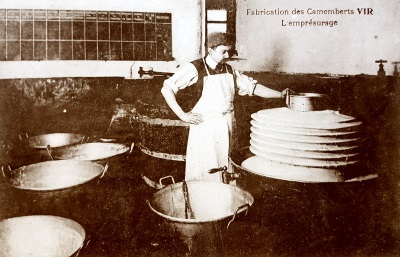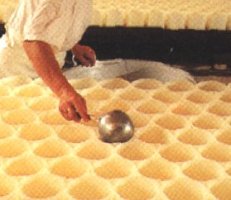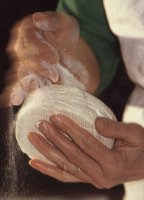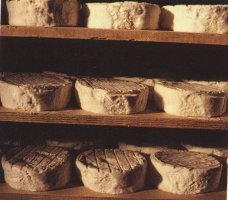
Before relishing that exceptional cheese, one ought to know how it is made. You will discover that the manufacture of the camembert is rather an exhausting operation...
The method described in this page should be followed by dairies that receive
the AOC (Appelation d'Origine Controlée), a special french trade name, given
to producers (not only in the cheese-making industry) who respect a high level
of quality.
It takes approximately two days, following this method, to make a camembert.
The ingredients
Milk is obviously the most important ingredient of the camembert. In order to respect the norms as well as the tradition the milk should come from the Normandy countryside
During the whole process, the milk temperature should not rise over 37 ºC (98.6 ºF).
The manufacturing
First, whole milk is poured into large containers called "bassines
normandes" (Norman bowls). The aim of that stage is to make the
milk coagulate/curdle. In conditions that are different in every dairy,
the rennet* is added to the milk, and one should wait 1h20 before the
beginning of the next step. At the end of that period, the milk has
formed into curds.
*Rennet is an enzyme that reduces the time necessary to separate the
liquids from the solids.

Adding the rennet in the "VIR" dairy (Old postcard)
Then comes the moulding. This is particular to camembert, because the curdled milk should be put in the mould with a special ladle, in at least four time (That operation lasts often more than 4 hours!). Extreme caution should be taken to prevent the curds from being shaken.

The next step is rather easy in comparison. The curds are perfectly levelled
in the mould.
To drain off whey, the futur camembert is put on shelves, for four to five
hours and then turned over.
The next morning, the camembert, which has now its final shape, is taken
out of its mould, and set on a tray in a salting room. There, it is covered
on both sides with a thin layer of salt and finally with a precious fungus
"penicillium candidum". That fungus replaced the genuine "penicillium
camembertii" that was sometimes responsible of blue moistures on the
cheese.
The active part of the making is now over... Nevertheless, the camembert is not yet ready for consumption, it should be placed on special shelves "les haloirs" for approximately 12 days .


Finally it is packed in its famous wood box, and sent to the consumers.
After 21 days, it is said to be "affiné" (refined) and "à point",
30 to 35 days after its birth.
The controls:
To receive the AOC, a Norman camembert should respect several norms. A few of them are listed below...
- During the whole process, the milk temperature should not rise over
37 °C (98.6 ºF). No milk powder, concentred milk, or lactic proteins
should be added to that camembert
- The moulding should be done with a ladle in at least four times. The
size of the laddle should be approximately the same as the size of the
mould.
- The salt should only be a "dry" one ( in french "sel
sec").
- At least 45% fat content in a camembert.
- At least 115g of dry matter in a camembert.
- The whole process is controlled by a specific commission composed
of veterinarians, milk quality specialists, producers and members of
the french administration. This commission tests the quality of the
product in the farms and at each step of the making until the cheese
merchants receive it.
